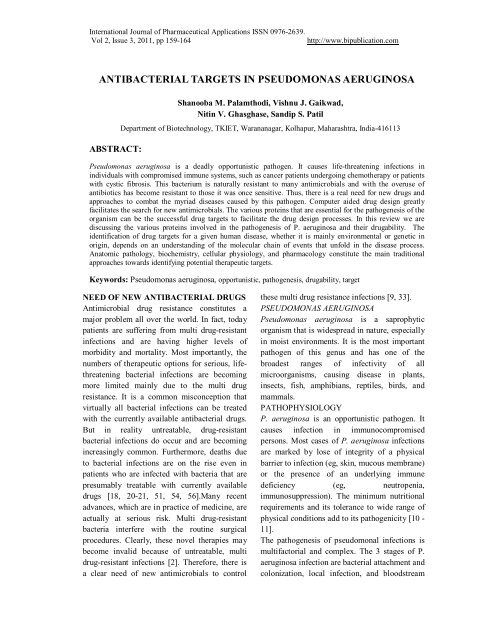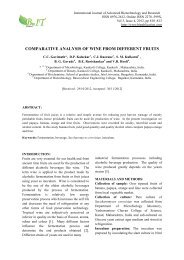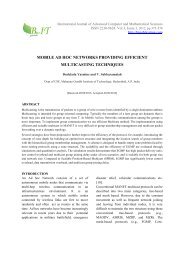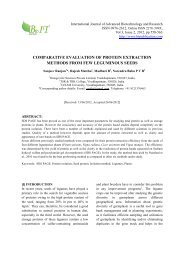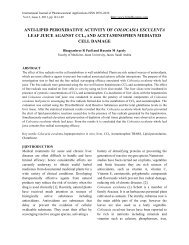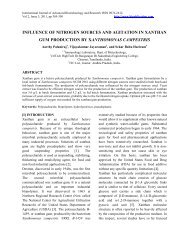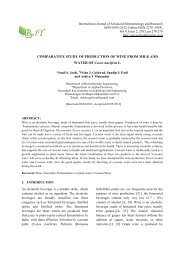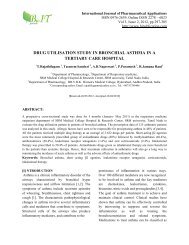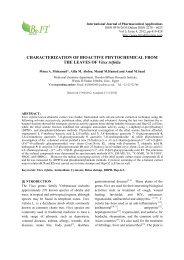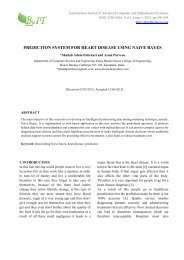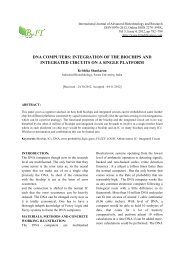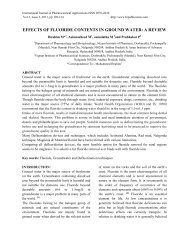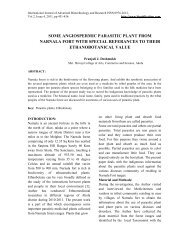antibacterial targets in pseudomonas aeruginosa - ResearchGate
antibacterial targets in pseudomonas aeruginosa - ResearchGate
antibacterial targets in pseudomonas aeruginosa - ResearchGate
You also want an ePaper? Increase the reach of your titles
YUMPU automatically turns print PDFs into web optimized ePapers that Google loves.
International Journal of Pharmaceutical Applications ISSN 0976-2639.<br />
Vol 2, Issue 3, 2011, pp 159-164<br />
http://www.bipublication.com<br />
ANTIBACTERIAL TARGETS IN PSEUDOMONAS AERUGINOSA<br />
ABSTRACT:<br />
Shanooba M. Palamthodi, Vishnu J. Gaikwad,<br />
Nit<strong>in</strong> V. Ghasghase, Sandip S. Patil<br />
Department of Biotechnology, TKIET, Warananagar, Kolhapur, Maharashtra, India-416113<br />
Pseudomonas aerug<strong>in</strong>osa is a deadly opportunistic pathogen. It causes life-threaten<strong>in</strong>g <strong>in</strong>fections <strong>in</strong><br />
<strong>in</strong>dividuals with compromised immune systems, such as cancer patients undergo<strong>in</strong>g chemotherapy or patients<br />
with cystic fibrosis. This bacterium is naturally resistant to many antimicrobials and with the overuse of<br />
antibiotics has become resistant to those it was once sensitive. Thus, there is a real need for new drugs and<br />
approaches to combat the myriad diseases caused by this pathogen. Computer aided drug design greatly<br />
facilitates the search for new antimicrobials. The various prote<strong>in</strong>s that are essential for the pathogenesis of the<br />
organism can be the successful drug <strong>targets</strong> to facilitate the drug design processes. In this review we are<br />
discuss<strong>in</strong>g the various prote<strong>in</strong>s <strong>in</strong>volved <strong>in</strong> the pathogenesis of P. aerug<strong>in</strong>osa and their drugability. The<br />
identification of drug <strong>targets</strong> for a given human disease, whether it is ma<strong>in</strong>ly environmental or genetic <strong>in</strong><br />
orig<strong>in</strong>, depends on an understand<strong>in</strong>g of the molecular cha<strong>in</strong> of events that unfold <strong>in</strong> the disease process.<br />
Anatomic pathology, biochemistry, cellular physiology, and pharmacology constitute the ma<strong>in</strong> traditional<br />
approaches towards identify<strong>in</strong>g potential therapeutic <strong>targets</strong>.<br />
Keywords: Pseudomonas aerug<strong>in</strong>osa, opportunistic, pathogenesis, drugability, target<br />
NEED OF NEW ANTIBACTERIAL DRUGS<br />
Antimicrobial drug resistance constitutes a<br />
major problem all over the world. In fact, today<br />
patients are suffer<strong>in</strong>g from multi drug-resistant<br />
<strong>in</strong>fections and are hav<strong>in</strong>g higher levels of<br />
morbidity and mortality. Most importantly, the<br />
numbers of therapeutic options for serious, lifethreaten<strong>in</strong>g<br />
bacterial <strong>in</strong>fections are becom<strong>in</strong>g<br />
more limited ma<strong>in</strong>ly due to the multi drug<br />
resistance. It is a common misconception that<br />
virtually all bacterial <strong>in</strong>fections can be treated<br />
with the currently available <strong>antibacterial</strong> drugs.<br />
But <strong>in</strong> reality untreatable, drug-resistant<br />
bacterial <strong>in</strong>fections do occur and are becom<strong>in</strong>g<br />
<strong>in</strong>creas<strong>in</strong>gly common. Furthermore, deaths due<br />
to bacterial <strong>in</strong>fections are on the rise even <strong>in</strong><br />
patients who are <strong>in</strong>fected with bacteria that are<br />
presumably treatable with currently available<br />
drugs [18, 20-21, 51, 54, 56].Many recent<br />
advances, which are <strong>in</strong> practice of medic<strong>in</strong>e, are<br />
actually at serious risk. Multi drug-resistant<br />
bacteria <strong>in</strong>terfere with the rout<strong>in</strong>e surgical<br />
procedures. Clearly, these novel therapies may<br />
become <strong>in</strong>valid because of untreatable, multi<br />
drug-resistant <strong>in</strong>fections [2]. Therefore, there is<br />
a clear need of new antimicrobials to control<br />
these multi drug resistance <strong>in</strong>fections [9, 33].<br />
PSEUDOMONAS AERUGINOSA<br />
Pseudomonas aerug<strong>in</strong>osa is a saprophytic<br />
organism that is widespread <strong>in</strong> nature, especially<br />
<strong>in</strong> moist environments. It is the most important<br />
pathogen of this genus and has one of the<br />
broadest ranges of <strong>in</strong>fectivity of all<br />
microorganisms, caus<strong>in</strong>g disease <strong>in</strong> plants,<br />
<strong>in</strong>sects, fish, amphibians, reptiles, birds, and<br />
mammals.<br />
PATHOPHYSIOLOGY<br />
P. aerug<strong>in</strong>osa is an opportunistic pathogen. It<br />
causes <strong>in</strong>fection <strong>in</strong> immunocompromised<br />
persons. Most cases of P. aerug<strong>in</strong>osa <strong>in</strong>fections<br />
are marked by lose of <strong>in</strong>tegrity of a physical<br />
barrier to <strong>in</strong>fection (eg, sk<strong>in</strong>, mucous membrane)<br />
or the presence of an underly<strong>in</strong>g immune<br />
deficiency (eg, neutropenia,<br />
immunosuppression). The m<strong>in</strong>imum nutritional<br />
requirements and its tolerance to wide range of<br />
physical conditions add to its pathogenicity [10 -<br />
11].<br />
The pathogenesis of pseudomonal <strong>in</strong>fections is<br />
multifactorial and complex. The 3 stages of P.<br />
aerug<strong>in</strong>osa <strong>in</strong>fection are bacterial attachment and<br />
colonization, local <strong>in</strong>fection, and bloodstream
ANTIBACTERIAL TARGETS IN PSEUDOMONAS AERUGINOSA<br />
dissem<strong>in</strong>ation and systemic disease. The<br />
importance of colonization and adherence is<br />
most evident <strong>in</strong> the context of respiratory tract<br />
<strong>in</strong>fection <strong>in</strong> patients with cystic fibrosis [13-15,<br />
31]. Production of extracellular proteases<br />
enhances the virulence of this pathogen by<br />
assist<strong>in</strong>g <strong>in</strong> bacterial adherence and <strong>in</strong>vasion [37,<br />
46, 55, 57].<br />
PSEUDOMONAS AERUGINOSA<br />
INFECTIONS<br />
P. aerug<strong>in</strong>osa causes life-threaten<strong>in</strong>g <strong>in</strong>fections<br />
<strong>in</strong> <strong>in</strong>dividuals with compromised immune<br />
systems, such as cancer patients undergo<strong>in</strong>g<br />
chemotherapy or patients with cystic fibrosis.<br />
Pseudomonas aerug<strong>in</strong>osa <strong>in</strong>fections can <strong>in</strong>volve<br />
any part of the body- respiratory tract, central<br />
nervous system, cardiovascular system, ear, eye,<br />
gastro<strong>in</strong>test<strong>in</strong>al system, ur<strong>in</strong>ary tract, sk<strong>in</strong> and<br />
bones and jo<strong>in</strong>ts [22, 27, 35].<br />
In plants, P. aerug<strong>in</strong>osa <strong>in</strong>duces symptoms of<br />
soft rot with Arabidopsis thaliana. It is a<br />
powerful pathogen with Arabidopsis.<br />
Pathogenesis <strong>in</strong> Arabidopsis <strong>in</strong>volves the<br />
follow<strong>in</strong>g steps: attachment to the leaf surface,<br />
congregation of bacteria at and <strong>in</strong>vasion through<br />
stomata or wounds, colonization of <strong>in</strong>tercellular<br />
spaces, and concomitant disruption of plant cell<br />
wall and membrane structures, basipetal<br />
movement along the vascular parenchyma, and<br />
maceration and rott<strong>in</strong>g of the petiole and central<br />
bud [47].<br />
Given the critical importance of Pseudomonas<br />
aerug<strong>in</strong>osa as an opportunistic pathogen, it is<br />
necessary to consider novel <strong>targets</strong> for<br />
therapeutic development. This is especially true<br />
as this bacterium is resistant to many<br />
antimicrobials [33, 48]. The resistance is<br />
ma<strong>in</strong>ly due to the low permeability of the<br />
bacterial cellular envelope [31]. Thus, there is a<br />
real need for new drugs and approaches to<br />
control the myriad of diseases caused by this<br />
pathogen [39].<br />
TARGETS FOR DRUG DISCOVERY [36]<br />
Exotox<strong>in</strong> A<br />
Exotox<strong>in</strong> A is one of the major virulence factor<br />
<strong>in</strong> P. aerug<strong>in</strong>osa <strong>in</strong>fections such as septicemia,<br />
corneal <strong>in</strong>fections and lung <strong>in</strong>fections [8, 50]. P.<br />
aerug<strong>in</strong>osa exotox<strong>in</strong> A enhances the<br />
pathogenicity of this bacterium via <strong>in</strong>hibit<strong>in</strong>g the<br />
production of pro-<strong>in</strong>flammatory cytok<strong>in</strong>es. This<br />
<strong>in</strong>dicates that Exotox<strong>in</strong> A can be a potential<br />
target for the development of a novel antibiotic<br />
aga<strong>in</strong>st P. aerug<strong>in</strong>osa.<br />
Exoenzyme S<br />
Exoenzyme S (ExoS) is a 49-kDa ADPribosyltransferase<br />
which plays an important role<br />
<strong>in</strong> P. aerug<strong>in</strong>osa pathogenesis [23]. Virtually all<br />
pneumonia and cystic fibrosis (CF) pulmonary<br />
Pseudomonas isolates produces P. aerug<strong>in</strong>osa<br />
virulence factor exoenzyme S [17]. Increased<br />
levels of ExoS correlate with <strong>in</strong>creased<br />
pulmonary damage <strong>in</strong> animal models and CF<br />
patients [41-44]. Target<strong>in</strong>g ExoS may<br />
effectively reduce the P. aerug<strong>in</strong>osa <strong>in</strong>fections.<br />
Flagell<strong>in</strong><br />
Flagella P. aerug<strong>in</strong>osa conta<strong>in</strong> the prote<strong>in</strong><br />
flagell<strong>in</strong> as a major structural component.<br />
Flagell<strong>in</strong> b<strong>in</strong>ds to the host cell membrane<br />
glycolipid. B<strong>in</strong>d<strong>in</strong>g to the glycolipid may change<br />
the transport properties of epithelial cells [19,<br />
38]. Also the flagellum of Pseudomonas<br />
aerug<strong>in</strong>osa is essential for resistance to clearance<br />
by the surfactant prote<strong>in</strong> A which is an<br />
important lung <strong>in</strong>nate immune prote<strong>in</strong> that kills<br />
microbial pathogens by opsonization and<br />
membrane permeabilization [43-44, 61].<br />
Flagell<strong>in</strong> can be a successful drug target.<br />
Pyocyan<strong>in</strong><br />
Pyocyan<strong>in</strong> is the blue phenaz<strong>in</strong>e pigment that is<br />
produced by P. aerug<strong>in</strong>osa. Pyocyan<strong>in</strong> slower<br />
the ciliary beat and disrupts the <strong>in</strong>tegrity of the<br />
epithelium <strong>in</strong> vitro. Also it results <strong>in</strong> slow<strong>in</strong>g of<br />
mucociliary transport <strong>in</strong> gu<strong>in</strong>ea pig trachea <strong>in</strong><br />
vivo. Pyocyan<strong>in</strong>-<strong>in</strong>duced ciliary slow<strong>in</strong>g is<br />
associated with a decrease <strong>in</strong> both <strong>in</strong>tracellular<br />
cAMP and ATP. Studies revealed that the agents<br />
that raise <strong>in</strong>tracellular cAMP levels <strong>in</strong>hibit the<br />
effect of pyocyan<strong>in</strong> on epithelium. This reflects<br />
that <strong>in</strong>hibition of pyocyan<strong>in</strong> may prevent the<br />
pathogenesis of p. aerug<strong>in</strong>osa.<br />
Protease IV<br />
Protease IV, is a 26 kDa ser<strong>in</strong>e endoprotease,<br />
secreted by most P. aerug<strong>in</strong>osa stra<strong>in</strong>s caus<strong>in</strong>g<br />
microbial keratitis. In association with other<br />
proteases protease IV has a major role <strong>in</strong> corneal<br />
virulence. The virulence of protease IV <strong>in</strong> ocular<br />
Shanooba M. Palamthodi, et al. 160
ANTIBACTERIAL TARGETS IN PSEUDOMONAS AERUGINOSA<br />
<strong>in</strong>fection has been attributed to the destruction of<br />
host prote<strong>in</strong>s, <strong>in</strong>clud<strong>in</strong>g fibr<strong>in</strong>ogen and<br />
components of the immune system [16].<br />
Protease IV also degrades structural prote<strong>in</strong>s<br />
such as elast<strong>in</strong>, facilitat<strong>in</strong>g bacterial adhesion<br />
and <strong>in</strong>fection [53]. This leads to the conclusion<br />
that protease IV can be a suitable target <strong>in</strong><br />
controll<strong>in</strong>g P. aerug<strong>in</strong>osa pathogenesis.<br />
Alkal<strong>in</strong>e protease<br />
Alkal<strong>in</strong>e protease is one of the important<br />
enzymes <strong>in</strong> corneal opacity and<br />
neovascularization [32]. Also Pseudomonas<br />
aerug<strong>in</strong>osa alkal<strong>in</strong>e protease degrades human<br />
gamma <strong>in</strong>terferon and <strong>in</strong>hibits its bioactivity<br />
[26]. Studies showed that <strong>in</strong>hibition of this<br />
prote<strong>in</strong> will help <strong>in</strong> reduc<strong>in</strong>g the harmful effects<br />
of P. aerug<strong>in</strong>osa <strong>in</strong>fections. But s<strong>in</strong>ce many<br />
virulence factors are <strong>in</strong>volved <strong>in</strong> the<br />
pathogenesis loss of a s<strong>in</strong>gle virulence factor<br />
such as alkal<strong>in</strong>e protease does not significantly<br />
affect the ability of P. aerug<strong>in</strong>osa to cause<br />
disease <strong>in</strong> the eye. Therefore, any therapeutic<br />
<strong>in</strong>tervention to prevent <strong>in</strong>fection or limit tissue<br />
damage dur<strong>in</strong>g <strong>in</strong>fection from bacterial<br />
exoprote<strong>in</strong>s should not be targeted towards a<br />
s<strong>in</strong>gle protease or tox<strong>in</strong>. Instead comb<strong>in</strong>ation<br />
therapy which will target more than one<br />
virulence factors will control the <strong>in</strong>fection<br />
effectively [40].<br />
FtsZ prote<strong>in</strong><br />
FtsZ is the key prote<strong>in</strong> <strong>in</strong> the cell division<br />
mach<strong>in</strong>ery. Polymerization of FtsZ <strong>in</strong>to a<br />
macromolecular structure termed the Z r<strong>in</strong>g is a<br />
key event <strong>in</strong> bacterial cell division. Its<br />
polymerization <strong>in</strong>to Z r<strong>in</strong>g and the GTPase<br />
activity are essential for the separation of<br />
daughter cells. Agents <strong>in</strong>terfer<strong>in</strong>g with FtsZ<br />
polymerization potently <strong>in</strong>hibit septum<br />
formation and cell division. So this class of<br />
compounds can constitute a new class of<br />
antibiotics [6-7, 34].<br />
Isocitrate lyase (ICL)<br />
The glyoxylate pathway plays an important role<br />
<strong>in</strong> P. aerug<strong>in</strong>osa pathogenesis. Isocitrate lyase is<br />
the key enzyme <strong>in</strong> the glyoxylate pathway. ICL<br />
is essential for aerobic as well as anaerobic<br />
utilization of carbon sources. Studies us<strong>in</strong>g<br />
animal model systems of <strong>in</strong>fection show that It<br />
is required for bacterial persistence [15]. Recent<br />
studies raise the possibility of controll<strong>in</strong>g P.<br />
aerug<strong>in</strong>osa <strong>in</strong>fections with<strong>in</strong> the CF lung with<br />
the use of drugs that <strong>in</strong>hibit isocitrate lyase [52].<br />
The apparent absence of this enzyme <strong>in</strong> humans<br />
makes it an attractive therapeutic target.<br />
LpxC<br />
LpxC [UDP-(3-O-acyl)-N-acetyl glucosam<strong>in</strong>e<br />
deacetylase] is a metalloenzyme that catalyzes<br />
the first step <strong>in</strong> the lipid A biosynthesis <strong>in</strong><br />
bacteria [58]. Lipid A is a component of<br />
lipopolysaccharide which has a critical role <strong>in</strong><br />
membrane <strong>in</strong>tegrity and host resistance.<br />
Therefore target<strong>in</strong>g the conserved<br />
lipopolysaccharide biosynthetic enzymes is<br />
attractive for design of novel <strong>antibacterial</strong> drugs.<br />
In P. aerug<strong>in</strong>osa LpxC is essential for growth of<br />
the organism. Therefore target<strong>in</strong>g LpxC is a<br />
good therapeutic approach to cure P. aerug<strong>in</strong>osa<br />
<strong>in</strong>fections [12, 24, 28-29, 36, 59].<br />
Cytotox<strong>in</strong><br />
Pseudomonas aerug<strong>in</strong>osa produces a 29 kDa<br />
cytotox<strong>in</strong> that causes the formation of pores with<br />
2 nm diameter <strong>in</strong> the plasma membranes of<br />
many different eukaryotic cells [3-4]. P.<br />
aerug<strong>in</strong>osa may protect itself from such basic<br />
host defenses through the production of<br />
cytotox<strong>in</strong>. P. aerug<strong>in</strong>osa cytotox<strong>in</strong>, previously<br />
named leukocid<strong>in</strong>, <strong>in</strong>activates eukaryotic cells<br />
by form<strong>in</strong>g lesions or pores <strong>in</strong> the membrane of<br />
target cells of the immune system. This causes<br />
<strong>in</strong>creased plasma membrane permeability to<br />
small molecules and ions [30]. Inhibition of this<br />
may prevent the pathogenesis of p. aerug<strong>in</strong>osa.<br />
Rhamnolipids<br />
Rhamnolipids act as virulence factors because<br />
they severely affect normal tracheal ciliary<br />
function , <strong>in</strong>hibit the phagocytic response of<br />
macrophages. Also they act as heat-stable<br />
hemolys<strong>in</strong>s. Swarm<strong>in</strong>g motility of P. aerug<strong>in</strong>osa<br />
is affected by rhamnolipids by a reduction of<br />
surface tension which helps <strong>in</strong> the surface<br />
condition<strong>in</strong>g needed for efficient colonization<br />
[1, 25]. Therefore the enzymes <strong>in</strong>volved <strong>in</strong> the<br />
rhanmolipid biosynthetic pathway (Figure: 1)<br />
can be good <strong>targets</strong> for drug discovery.<br />
Shanooba M. Palamthodi, et al. 161
ANTIBACTERIAL TARGETS IN PSEUDOMONAS AERUGINOSA<br />
Glucose-6-phosphate<br />
AlgC<br />
Glucose-1-phosphate<br />
RmlA<br />
dTDP-D-glucose<br />
RmlB<br />
dTDP-6-deoxy-D-4-hexulose<br />
RmlC<br />
fattyacid de novo synthesis<br />
RhlG<br />
3-ketoacyl-ACP<br />
dTDP-6-deoxy-L-lyxo-4-hexulose 3-hydroxyacyl-ACP<br />
RmlD<br />
RhlA<br />
dTDP-L-rhamnose + 3-(3-hydroxyalkanoyloxy)alkanoates<br />
RhlB<br />
mono-rhamnolipids<br />
RhlC<br />
di-rhamnolipids<br />
Figur 1: Rhamnolipids Biosynthetic Pathway<br />
Esterase EstA<br />
Esterase EstA is an autotransporter prote<strong>in</strong><br />
located <strong>in</strong> the outer membrane. Autotransporters<br />
predom<strong>in</strong>antly show physiological functions<br />
related to the virulence of the correspond<strong>in</strong>g<br />
organisms. EstA was found to be required for<br />
full virulence <strong>in</strong> a rat model of chronic<br />
respiratory <strong>in</strong>fection. Inactivation of the estA<br />
gene not only resulted <strong>in</strong> rhamnolipid deficiency<br />
but also <strong>in</strong>fluenced other virulence-related<br />
functions like cellular motility, i.e., swimm<strong>in</strong>g,<br />
twitch<strong>in</strong>g motility, and swarm<strong>in</strong>g [1, 60]. So this<br />
prote<strong>in</strong> can be a good drug target.<br />
Polyphosphate K<strong>in</strong>ase<br />
PPK is responsible for the synthesis of<br />
polyphosphate from ATP. It is required for<br />
motility and is essential for quorum sens<strong>in</strong>g and<br />
virulence. Also <strong>in</strong>hibition of PPK prevents the<br />
formation of the biofilm. PPK is highly<br />
conserved <strong>in</strong> prokaryotes and is absent <strong>in</strong><br />
eukaryotes. This all suggests that PPK is a<br />
therapeutic target to treat P. aerug<strong>in</strong>osa<br />
<strong>in</strong>fections. Also s<strong>in</strong>ce PPK is <strong>in</strong>volved <strong>in</strong> the<br />
cellular metabolism rather than <strong>in</strong> an essential<br />
function, the chances to provoke resistance are<br />
less [45, 49].<br />
REFERENCES<br />
1. Al-Tahhan, R.A., Sandr<strong>in</strong>, T.R., Bodour, A.A.,<br />
Maier, R.M. (2000). Rhamnolipid-<strong>in</strong>duced removal<br />
of lipopolysaccharide from Pseudomonas<br />
aerug<strong>in</strong>osa: effect on cell surface properties and<br />
<strong>in</strong>teraction with hydrophobic substrates. Applied and<br />
Environtal Microbiology, 66:3262–3268.<br />
2. Aparna., Madhu, S., Sarita, Y. (2008). Biofilms:<br />
microbes and disease. The Brazilian Journal of<br />
Infectious Diseases, 12:526-530.<br />
3. Baltch, A. L., Obrig, T.G., Snith, R.P., Hammer,<br />
M.C., Conroy, J.V. (1987). Production of cytotox<strong>in</strong><br />
by cl<strong>in</strong>ical stra<strong>in</strong>s of Pseudomonas aerug<strong>in</strong>osa.<br />
Canadian Journal of Microbiology, 33: 104-111.<br />
4. Baltch, A.L., Hammer, M.C., Smith, R.P., et al.<br />
(1985). Effects of Pseudomonas aerug<strong>in</strong>osa cytotox<strong>in</strong><br />
on human serum and granulocytes and their<br />
microbicidal, phagocytic, and chemotactic functions.<br />
Infectious Immunology, 48:498-506.<br />
5. Bentzmann, S.D., Roger, P., Puchelle, E. (1996).<br />
Pseudomonas aerug<strong>in</strong>osa adherence to remodell<strong>in</strong>g<br />
respiratory epithelium. European Respiratory<br />
Journal 9: 2145–2150.<br />
6. Bleau, C., Beaumont, M., Sanschagr<strong>in</strong>, F.,<br />
Voyer, N., Levesque, R.C. (2007). Parallel solid<br />
synthesis of <strong>in</strong>hibitors of the essential cell division<br />
FtsZ enzyme as a new potential class of <strong>antibacterial</strong>.<br />
Bioorganic & Medic<strong>in</strong>al Chemistry, 15:1330–1340.<br />
7. Bleau, C.P., Sanschagr<strong>in</strong>, F., Levesque, R.C.<br />
(2004). Identification of Pseudomonas aerug<strong>in</strong>osa<br />
FtsZ peptide <strong>in</strong>hibitors as a tool for development of<br />
novel antimicrobials. Journal of Antimicrobial<br />
Chemotherapy, 40:235-238.<br />
8. Burke, V., Rob<strong>in</strong>son, J. O., Richardson, C. J. L.<br />
& Bundell, C. S. (1991). Longitud<strong>in</strong>al studies of<br />
virulence factors of Pseudomonas aerug<strong>in</strong>osa <strong>in</strong><br />
cystic fibrosis. Pathology 23: 145-148.<br />
9. Cegelski, L., Marshall, G.R., Eldridge, G.R.,<br />
Hultgren, S.J. (2008). The biology and future<br />
prospects of antivirulence therapy. Microbiology,<br />
6:17-27.<br />
10. Celik, I., Cihangiroglu, M., Yilmaz, T., Kohle,<br />
U., Akbulut, A. (2006). The prevalence of<br />
bacteraemia-related ret<strong>in</strong>al lesions <strong>in</strong> seriously ill<br />
patients. Journal of <strong>in</strong>fection, 52:97–100.<br />
11. Church, D., Elsayed, S., Reid, O., W<strong>in</strong>ston, B.,<br />
L<strong>in</strong>dsay, R. (2006). Burn wound <strong>in</strong>fections. Cl<strong>in</strong>ical<br />
Microbiology Reviews, 19:403-434.<br />
12. Clements, J.M., Coignard, F., Johnson, I.,<br />
Chandler, S., Palan, S., Waller, A., Wijkmans, J.,<br />
Hunter, M.G. (2002). Antibacterial activities and<br />
characterization of novel <strong>in</strong>hibitors of LpxC.<br />
Antimicrobial Agents and Chemotherapy, 46: 1793–<br />
1799.<br />
13. Cloete, T.E., Jacobs L. (2001). Surfactants and<br />
the attachment of Pseudomonas aerug<strong>in</strong>osa to 3CR12<br />
sta<strong>in</strong>less steel and glass. Water SA 27: 21-26.<br />
Shanooba M. Palamthodi, et al. 162
ANTIBACTERIAL TARGETS IN PSEUDOMONAS AERUGINOSA<br />
14. Delden, C.V., Iglewski, B.H. (1998). Cell-to-cell<br />
signall<strong>in</strong>g and Pseudomonas aerug<strong>in</strong>osa <strong>in</strong>fections.<br />
Emerg<strong>in</strong>g Infectious diseases, 4:551-560.<br />
15. Dıaz-Perez A.L., et al. (2007). Identi¢cation of<br />
the aceA gene encod<strong>in</strong>g isocitrate lyase required for<br />
the growth ofPseudomonas aerug<strong>in</strong>osa onacetate,<br />
acyclic terpenes and leuc<strong>in</strong>e Federation of European<br />
Microbiological Societies Microbiology Letters, 269:<br />
309–316.<br />
16. Engel, L.S., Hill, J.M., Moreau, J.M., Green,<br />
L.C., Hobden, J.A., O’Callaghan, R.J. (1998).<br />
Pseudomonas aerug<strong>in</strong>osa protease IV produces<br />
corneal damage and contributes to bacterial<br />
virulence. Investigative Ophthalmology & Visual<br />
Science, 39: 662–665.<br />
17. Epelman, S., Neely, G.G., L<strong>in</strong>g Ma, L., et al.<br />
(2002). Dist<strong>in</strong>ct fates of monocytes and T cells<br />
directly activated by Pseudomonas aerug<strong>in</strong>osa<br />
exoenzyme S Journal of Leukocyte Biology, 71: 458-<br />
468.<br />
18. Falagas, M.E., Bliziotis, I.A., Kasiakou, S.K.,<br />
Samonis, G., Athanassopoulou, P., Michalopoulos,<br />
A. (2005). Outcome of <strong>in</strong>fections due to pandrugresistant<br />
(PDR) Gram-negative bacteria. Infectious<br />
Diseases, 5:24-29.<br />
19. Feldman, M., Bryan, R., Rajan, S., Scheffler, L.,<br />
Brunnert, S., et al. (1998). Role of flagella <strong>in</strong><br />
pathogenesis of Pseudomonas aerug<strong>in</strong>osa pulmonary<br />
<strong>in</strong>fection. Infectious Immunology, 66: 43–51.<br />
20. Fischbach, M.A., Walsh, C.T. (2009).<br />
Antibiotics for emerg<strong>in</strong>g pathogens. Science, 325:<br />
1089-1093.<br />
21. Fish, D.N., Ohl<strong>in</strong>ger, M.J. (2006). Antimicrobial<br />
resistance: factors and outcomes. Critical care<br />
cl<strong>in</strong>ics, 22:291-311.<br />
22. Fleiszig, S.M., Evanes, D.J. (2002). The<br />
pathogenesis of bacterial keratitis: studies with<br />
Pseudomonas aerug<strong>in</strong>osa. Cl<strong>in</strong>ical and Experimental<br />
Optometry, 85:271-278.<br />
23. Ganesan, A.K., V<strong>in</strong>cent, T.S., Olson, J.C.,<br />
Barbieri, J.T. (1999). Pseudomonas aerug<strong>in</strong>osa<br />
Exoenzyme S Disrupts Ras-mediated Signal<br />
Transduction by Inhibit<strong>in</strong>g Guan<strong>in</strong>e Nucleotide<br />
Exchange Factor-catalyzed Nucleotide Exchange.<br />
The Journal Of Biological Chemistry, 274: 21823–<br />
21829.<br />
24. Heath, R.J., White, S.W., Rock, C.O. (2001).<br />
Lipid biosynthesis as a target for <strong>antibacterial</strong> agents.<br />
Progress <strong>in</strong> Lipid Research, 40:467–497.<br />
25. Hori, K.., Marsudi, S., Unno, H. (2002).<br />
Simultaneous production of polyhydroxyalkanoates<br />
and rhamnolipids by Pseudomonas aerug<strong>in</strong>osa.<br />
Biotechnology and Bioeng<strong>in</strong>eer<strong>in</strong>g, 78:699–707.<br />
26. Horvat, R.T., Parmely, M.J. (1998).<br />
Pseudomonas aerug<strong>in</strong>osa alkal<strong>in</strong>e protease degrades<br />
human gamma <strong>in</strong>terferon and <strong>in</strong>hibits its bioactivity.<br />
Infectious immunology, 56: 2925-2932.<br />
27. Hua Zhu., Bandara R., Conibear CR., Thuruthyil<br />
SJ., Rice SA., Kjelleberg S., Givskov M., Willcox,<br />
D.P. (2004). Pseudomonas aerug<strong>in</strong>osa with LasI<br />
Quorum-Sens<strong>in</strong>g Deficiency dur<strong>in</strong>g Corneal<br />
Infection. Investigative Ophthalmology & Visual<br />
Science, 45: 1897-1903.<br />
28. Kadam, R.U., Chavan, A., Roy, N. (2007).<br />
Pharmacophoric features of Pseudomonas<br />
aerug<strong>in</strong>osa deacetylase LpxC <strong>in</strong>hibitors: An<br />
electronic and structural analysis. Bioorganic &<br />
Medic<strong>in</strong>al Chemistry Letters, 17:861–868.<br />
29. Kadam, R.U., Roy, N. (2006). Cluster analysis<br />
and two-dimensional quantitative structure–activity<br />
relationship (2D-QSAR) of Pseudomonas aerug<strong>in</strong>osa<br />
deacetylase LpxC <strong>in</strong>hibitors. Bioorganic & Medic<strong>in</strong>al<br />
Chemistry Letters, 16:5136–5143.<br />
30. Kluft<strong>in</strong>ger, J.L., Lutz, F., Hancock, E.W. (1989).<br />
Pseudomonas aerug<strong>in</strong>osa Cytotox<strong>in</strong>: Periplasmic<br />
Localization andInhibition of Macrophages.<br />
Infection and Immunity, 57: 882-886.<br />
31. Kobayashi, H., Kobayashi, O., and Kawai, S.<br />
(2009). Pathogenesis and cl<strong>in</strong>ical manifestations of<br />
chronic colonization by Pseudomonas aerug<strong>in</strong>osa<br />
and its biofilms <strong>in</strong> the airway tract. Japanese Society<br />
of Chemotherapy and The Japanese Association for<br />
Infectious Diseases, 15:125-142.<br />
32. Kreger, A.S., Gray, L.D. (1978). Purification of<br />
Pseudomonas aerug<strong>in</strong>osa proteases and microscopic<br />
characterization of pseudomonal protease-<strong>in</strong>duced<br />
rabbit comeal damage. Infectious Immunology, 19:<br />
630-648.<br />
33. Lambert, P.A. (2005). Bacterial resistance to<br />
antibiotics: Modified target sites. Advanced Drug<br />
Delivery Reviews, 57:1471–1485<br />
34. Lappchen, T., P<strong>in</strong>as, V.A., Hartog, A.F.,<br />
Koomen, G., Barbero, C.S., Andreu, J.M.,<br />
Trambaiolo, D., Lowe, J., Juhem, A., Popov, A.V.,<br />
Blaauwen, T. (2008). Prob<strong>in</strong>g FtsZ and tubul<strong>in</strong> with<br />
C8-substituted GTP analogs reveals differences <strong>in</strong><br />
their nucleotide b<strong>in</strong>d<strong>in</strong>g sites. Chemistry & Biology,<br />
15: 93-94.<br />
35. Ledbetter, E.C., Mun, J.J., Kowbel, D., Fleiszig,<br />
S.M. (2009). Pathogenic phenotype and genotype of<br />
Pseudomonas aerug<strong>in</strong>osa isolates from spontaneous<br />
can<strong>in</strong>e ocular <strong>in</strong>fections. Investigative<br />
Ophthalmology & Visual Science, 50:729-736.<br />
36. Li, J.D., Dohrman, A.F., Gallup, M., Miyata, S.,<br />
Gum, J.R., Kim, Y.S., Nadel, J.A., Pr<strong>in</strong>ce, A., Carol<br />
B., Basbaum, C.B. (1997). Transcriptional activation<br />
of muc<strong>in</strong> by Pseudomonas aerug<strong>in</strong>osa<br />
lipopolysaccharide <strong>in</strong> the pathogenesis of cystic<br />
fibrosis lung disease. Proceed<strong>in</strong>gs of the National<br />
Academy of Sciences, 94:967-972.<br />
37. Lyczak, J.B., Cannon, C.L., Pier, G.B. (2000).<br />
Establishment of Pseudomonas aerug<strong>in</strong>osa <strong>in</strong>fection:<br />
lessons from a versatile opportunist. Microbes and<br />
Infection, 2:1051–1060.<br />
38. Mahenthiral<strong>in</strong>gam, E., Campbell, M.E., Speert,<br />
D.P. (1994). Nonmotility and phagocytic resistance<br />
of Pseudomonas aerug<strong>in</strong>osa isolates from chronically<br />
colonized patients with cystic fibrosis. Infectious<br />
Immunology, 62: 596–605.<br />
39. Moniri, R., Mosayebi, Z., Movahedian, A.H.,<br />
Shanooba M. Palamthodi, et al. 163
ANTIBACTERIAL TARGETS IN PSEUDOMONAS AERUGINOSA<br />
Mossavi, G. (2006). Increas<strong>in</strong>g trend of antimicrobial<br />
drug-resistance <strong>in</strong> Pseudomonas aerug<strong>in</strong>osa caus<strong>in</strong>g<br />
septicaemia. Iranian Journal of Public Health, 35:58-<br />
62.<br />
40. Morihara, K.. (1964). Production of elastase and<br />
prote<strong>in</strong>ase by Pseudomonas aerug<strong>in</strong>osa. Journal of<br />
Bacteriology, 88: 745-757.<br />
41. Nicas, T.I., Frank, D.W., Lile, J.D., Iglewski,<br />
B.H. (1985). Role of exoenzyme S <strong>in</strong> chronic<br />
Pseudomonas aerug<strong>in</strong>osa lung <strong>in</strong>fections. European<br />
Journal of Cl<strong>in</strong>ical Microbiology, 4: 175–179.<br />
42. Olson, J.C., Fraylick, J.E., McGuffie, E.M.,<br />
Dolan, K.M., Yahr, T.L., Frank, D.W., V<strong>in</strong>cent, T.S.<br />
(1999). Interruption of multiple cellular processes <strong>in</strong><br />
HT-29 epithelial cells by Pseudomonas aerug<strong>in</strong>osa<br />
exoenzyme S. Infectious Immunology, 67: 2847–<br />
2854.<br />
43. Overhage, J., Ba<strong>in</strong>s, M., Brazas, M.D., Hancock,<br />
R.E. (2008). Swarm<strong>in</strong>g of Pseudomonas aerug<strong>in</strong>osa<br />
is a complex adaptation lead<strong>in</strong>g to <strong>in</strong>creased<br />
production of virulence factors and antibiotic<br />
resistance. Journal of Bacteriology, 190:2671–2679.<br />
44. Overhage, J., Lewenza, S., Marr, A.K., Hancock,<br />
R. E. (2007). Identification of genes <strong>in</strong>volved <strong>in</strong><br />
swarm<strong>in</strong>g motility us<strong>in</strong>g a Pseudomonas aerug<strong>in</strong>osa<br />
PAO1 m<strong>in</strong>i-Tn5-lux mutant library. Journal of<br />
Bacteriology, 189:2164–2169.<br />
45. Parks, Q.M., Hobden, J.A. (2005).<br />
Polyphosphate K<strong>in</strong>ase 1 and the ocular virulence of<br />
Pseudomonas aerug<strong>in</strong>osa. Investigative<br />
Ophthalmology & Visual Science, 46:248-251.<br />
46. Perumal, D., Lim, C.S., V<strong>in</strong>cent, T.K.C.,<br />
Sakharkar, K.R. (2008). A comb<strong>in</strong>ed computationalexperimental<br />
analyses of selected metabolic enzymes<br />
<strong>in</strong> Pseudomonas species.International Journal of<br />
Biological Sciences, 4:309-317.<br />
47. Pukatzki, S., Kess<strong>in</strong>, R.H., Mekalanos, J.J.<br />
(2002). The human pathogen Pseudomonas<br />
aerug<strong>in</strong>osa utilizes conserved virulence pathways to<br />
<strong>in</strong>fect the social amoeba Dictyostelium discoideum.<br />
Proceed<strong>in</strong>gs of the National Academy of Sciences,<br />
99:3159-3164.<br />
48. Rashid, A., Chowdhury, A., Rahman, S.H.,<br />
Begum, S.A., Muazzam, N. (2007). Infections by<br />
Pseudomonas aerug<strong>in</strong>osa and antibiotic resistance<br />
pattern of the isolates from Dhaka Medical College<br />
Hospital. Bangladesh Journal of Medical<br />
Microbiology, 1:48-51.<br />
49. Rashid, M.H., Rumbaugh, K., Passador, L.,<br />
Davies, D.G., Hamood, A.N., Iglewski, B.H., and<br />
Kornberg, A. (2000). Polyphosphate k<strong>in</strong>ase is<br />
essential for biofilm development, quorum sens<strong>in</strong>g,<br />
and virulence of Pseudomonas aerug<strong>in</strong>osa.<br />
Proceed<strong>in</strong>gs of the National Academy of Sciences,<br />
97:9636–9641.<br />
50. Sharma, S., Kaur, R.,Yadav, V., Harjai, K.,<br />
Joshi, K. (2004). Contribution of Exotox<strong>in</strong> A of<br />
Pseudomonas aerug<strong>in</strong>osa <strong>in</strong> acute and chronic<br />
experimental renal <strong>in</strong>fection. Japanese Journal of<br />
Infectious Diseases, 57: 119-120.<br />
51. Siegel, R.E. (2008). Emerg<strong>in</strong>g gram-negative<br />
antibiotic resistance: daunt<strong>in</strong>g challenges, decl<strong>in</strong><strong>in</strong>g<br />
sensitivities, and dire consequences. Respiratory<br />
Care, 53: 471-479.<br />
52. Silo-Suh, L.A., L<strong>in</strong>dsey, L., Hag<strong>in</strong>s, J.M.,<br />
Pamela A., Soko, P.A. (2008). Virulence<br />
determ<strong>in</strong>ants from a cystic fibrosis isolate of<br />
Pseudomonas aerug<strong>in</strong>osa <strong>in</strong>clude isocitrate lyase.<br />
Microbiology, 154:1616–1627.<br />
53. Smith,L., Rose, B. (2006). Protease IV<br />
production <strong>in</strong> Pseudomonas aerug<strong>in</strong>osa from the<br />
lungs of adults with cystic fibrosis. Journal of<br />
Medical Microbiology, 55: 1641–1644.<br />
54. Srifuengfung, S., Tiensasitom, C., Yungyuen, T.,<br />
Dhiraputra, C. (2004). Prevalence and antimicrobial<br />
susceptibility of Pseudomonas aerug<strong>in</strong>osa mucoid<br />
and non-mucoid type. Southeast Asian Journal of<br />
Tropical Medic<strong>in</strong>e & Public Health, 35:893-896.<br />
55. Tan, M.W., Rahme, L.G., Sternberg, J.A.,<br />
Tompk<strong>in</strong>s, R.G., Ausubel, F.M. (1999).<br />
Pseudomonas aerug<strong>in</strong>osa kill<strong>in</strong>g of Caenorhabditis<br />
elegans used to identify P. aerug<strong>in</strong>osa virulence<br />
factors. Proceed<strong>in</strong>gs of the National Academy of<br />
Sciences, 96:2408-2413.<br />
56. Tenover, F.C. (2006). Mechanisms of<br />
Antimicrobial Resistance <strong>in</strong> Bacteria. The American<br />
Journal of Medic<strong>in</strong>e, 119: S3–S10.<br />
57. Vrane, J., Dr<strong>in</strong>kovi, D.J., Zulj, I., Kruzic, V.,<br />
Turkovic, B., Maric, S. (2004). Adherence ability of<br />
Pseudomonas aerug<strong>in</strong>osa stra<strong>in</strong>s isolated from<br />
patients with cystic fibrosis to two different epithelial<br />
cells. Collegium Antropologicum, 2:675-680.<br />
58. White, R.J., Margolis, P.S., Trias, J., Yuan, Z.<br />
(2003). Target<strong>in</strong>g metalloenzymes: a strategy that<br />
works. Current Op<strong>in</strong>ion <strong>in</strong> Pharmacology, 3:502–<br />
507.<br />
59. Witte, P.R., Kl<strong>in</strong>e, T., Barb, A.W., Erw<strong>in</strong>, A.L.,<br />
Mansfield, B.E., McClerren, A.L., Pirrung, M.C.,<br />
Tumey, L.N., Warrener, P., Raetz, C.R., and Stover,<br />
C.K. (2006). Molecular validation of LpxC as an<br />
<strong>antibacterial</strong> drug target <strong>in</strong> Pseudomonas aerug<strong>in</strong>osa.<br />
Antimicrobial Agents and Chemotherapy, 50:2178-<br />
2184.<br />
60. Yang, L., Rybtke, M.T., Jakobsen, T.H.,<br />
Hentzer, M., Bjarnsholt, T., Givskov, M., Nielsen,<br />
T.T. (2009). Computer-aided identification of<br />
recognized drugs as Pseudomonas aerug<strong>in</strong>osa<br />
quorum-sens<strong>in</strong>g <strong>in</strong>hibitors. Antimicrobial Agents and<br />
Chemotherapy, 53:2432-2443.<br />
61. Zhang, S., McCormack, F. ., Levesque, R.C.,<br />
O’Toole, G.A., Lau, G.W. (2007). The Flagellum of<br />
Pseudomonas aerug<strong>in</strong>osa Is Required for Resistance<br />
to Clearance by Surfactant Prote<strong>in</strong> A. PLoS ONE, 2:<br />
1-11.<br />
Shanooba M. Palamthodi, et al. 164


